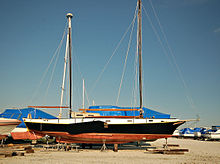Leeboard
Typically mounted in pairs on each side of a hull, leeboards function much like a centreboard, allowing shallow-draft craft to ply waters fixed keel boats cannot.
A disadvantage, where there is an inadequate fixed keel, is that they typically ship (bear) little ballast, which being on the far side delays the onset of unballasted craft's heeling, that is, to put up a good, constant resistance against the wind.
The classical, archetypal definition of ballast is a low, central weight to optimise centre of mass, reduce turning moment and therefore resistance to the boat keeling over, however tends to be higher in self-righting vessels.
Leeboards existed in China from at least the eighth century on warships that "held the ships, so that even when wind and wave arise in fury, they are neither driven sideways, nor overturn".
In particular, they allowed gundalows to take the hard to load and unload cargo in unimproved tidal areas, as well as readily conduct maintenance on their hulls.


